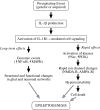New roles for interleukin-1 Beta in the mechanisms of epilepsy
- PMID: 17505552
- PMCID: PMC1867084
- DOI: 10.1111/j.1535-7511.2007.00165.x
New roles for interleukin-1 Beta in the mechanisms of epilepsy
Abstract
The mechanisms that transform a normal brain to an epileptic one are not fully understood. Interleukin-1 beta (IL-1beta) contributes to neuronal degeneration observed in several neurological disorders and recently has been implicated in neuronal injury that may accompany the process of epileptogenesis. This review presents the hypothesis that IL-1beta may contribute to the development of epilepsy via several mechanisms, including classical effects on neuronal survival and transcription pathways; novel rapid effects on receptor-gated ion channels; and long-lasting effects on expression of selective gene families. Thus, evidence that IL-1beta actions in epilepsy can be independent from the neurotoxic effects of this cytokine is presented.
Figures

Similar articles
-
Chemokine CCL2-CCR2 Signaling Induces Neuronal Cell Death via STAT3 Activation and IL-1β Production after Status Epilepticus.J Neurosci. 2017 Aug 16;37(33):7878-7892. doi: 10.1523/JNEUROSCI.0315-17.2017. Epub 2017 Jul 17. J Neurosci. 2017. PMID: 28716963 Free PMC article.
-
Inflammation in epileptogenesis after traumatic brain injury.J Neuroinflammation. 2017 Jan 13;14(1):10. doi: 10.1186/s12974-016-0786-1. J Neuroinflammation. 2017. PMID: 28086980 Free PMC article. Review.
-
Deep brain stimulation of the anterior nucleus of the thalamus reverses the gene expression of cytokines and their receptors as well as neuronal degeneration in epileptic rats.Brain Res. 2017 Feb 15;1657:304-311. doi: 10.1016/j.brainres.2016.12.020. Epub 2016 Dec 24. Brain Res. 2017. PMID: 28027874
-
Transient P2X7 Receptor Antagonism Produces Lasting Reductions in Spontaneous Seizures and Gliosis in Experimental Temporal Lobe Epilepsy.J Neurosci. 2016 Jun 1;36(22):5920-32. doi: 10.1523/JNEUROSCI.4009-15.2016. J Neurosci. 2016. PMID: 27251615 Free PMC article.
-
Inflammatory aspects of epileptogenesis: contribution of molecular inflammatory mechanisms.Acta Neuropsychiatr. 2017 Feb;29(1):1-16. doi: 10.1017/neu.2016.47. Epub 2016 Oct 3. Acta Neuropsychiatr. 2017. PMID: 27692004 Review.
Cited by
-
Dexamethasone Attenuates Hyperexcitability Provoked by Experimental Febrile Status Epilepticus.eNeuro. 2019 Nov 15;6(6):ENEURO.0430-19.2019. doi: 10.1523/ENEURO.0430-19.2019. Print 2019 Nov/Dec. eNeuro. 2019. PMID: 31685676 Free PMC article.
-
Interleukin-1β secretion in hippocampal sclerosis patients with mesial temporal lobe epilepsy.Neurol Int. 2013 Sep 16;5(3):e17. doi: 10.4081/ni.2013.e17. eCollection 2013. Neurol Int. 2013. PMID: 24147214 Free PMC article.
-
Zinc and Central Nervous System Disorders.Nutrients. 2023 Apr 29;15(9):2140. doi: 10.3390/nu15092140. Nutrients. 2023. PMID: 37432243 Free PMC article. Review.
-
Chemokine CCL2-CCR2 Signaling Induces Neuronal Cell Death via STAT3 Activation and IL-1β Production after Status Epilepticus.J Neurosci. 2017 Aug 16;37(33):7878-7892. doi: 10.1523/JNEUROSCI.0315-17.2017. Epub 2017 Jul 17. J Neurosci. 2017. PMID: 28716963 Free PMC article.
-
1400 W, a selective inducible nitric oxide synthase inhibitor, mitigates early neuroinflammation and nitrooxidative stress in diisopropylfluorophosphate-induced short-term neurotoxicity rat model.Front Mol Neurosci. 2023 Mar 17;16:1125934. doi: 10.3389/fnmol.2023.1125934. eCollection 2023. Front Mol Neurosci. 2023. PMID: 37008784 Free PMC article.
References
-
- Allan SM, Tyrrell PJ, Rothwell NJ. Interleukin-1 and neuronal injury. Nat Rev Immunol. 2005;5:629–640. - PubMed
-
- Vezzani A, Granata T. Brain inflammation in epilepsy: experimental and clinical evidence. Epilepsia. 2005;46:1724–1743. - PubMed
-
- Pitkanen A, Sutula TP. Is epilepsy a progressive disorder? Prospects for new therapeutic approaches in temporal-lobe epilepsy. Lancet Neurol. 2002;1:173–181. - PubMed
-
- Jobe PC, Mishra PK, Ludvig N, Dailey JW. Scope and contribution of genetic models to an understanding of the epilepsies. Crit Rev Neurobiol. 1991;6:183–220. - PubMed
-
- Holmes GL. Seizure-induced neuronal injury: animal data. Neurology. 2002;59(suppl. 5):S3–S6. - PubMed
LinkOut - more resources
Full Text Sources
Other Literature Sources

